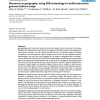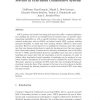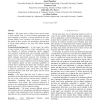2015 search results - page 302 / 403 » Hidden Software Capabilities |
BMCBI
2007
13 years 9 months ago
2007
Background: Metalloproteins are proteins capable of binding one or more metal ions, which may be required for their biological function, for regulation of their activities or for ...
BMCBI
2006
13 years 9 months ago
2006
Background: Many commonly used genome browsers display sequence annotations and related attributes as horizontal data tracks that can be toggled on and off according to user prefe...
FGCS
2006
13 years 9 months ago
2006
CSCL systems can benefit from using grids since they offer a common infrastructure enabling the access to an extended pool of resources that can provide supercomputing capabilitie...
JUCS
2008
13 years 9 months ago
2008
Abstract: Collaborative learning systems can be constructed following the serviceoriented computing paradigm. This allows educators to integrate external tools, offered as services...
IJWIS
2007
13 years 9 months ago
2007
Purpose – This paper aims to address some security issues in open systems such as service-oriented applications and grid computing. It proposes a security framework for these sy...



